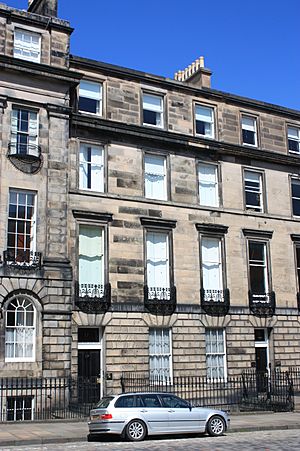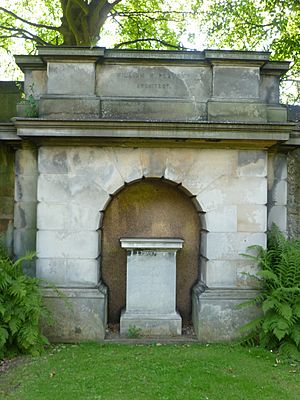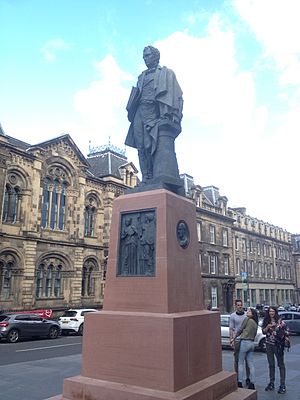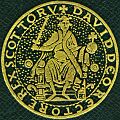William Henry Playfair facts for kids
Quick facts for kids
William Henry Playfair
FRSE
|
|
|---|---|
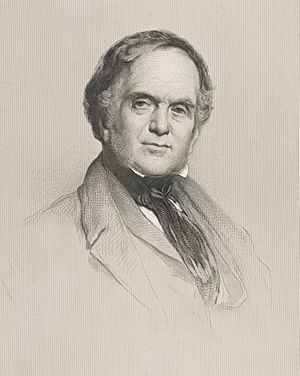 |
|
| Born | 15 May 1790 London, England
|
| Died | 19 March 1857 (aged 66) Edinburgh, Scotland
|
| Nationality | Scottish |
| Alma mater | University of Edinburgh |
| Occupation | Architect |
| Parent(s) | James Playfair |
| Buildings | National Gallery of Scotland Old College, University of Edinburgh Royal College of Surgeons of Edinburgh Royal Scottish Academy Building Dollar Academy |
| Signature | |
William Henry Playfair (born May 15, 1790 – died March 19, 1857) was a very important Scottish architect. He lived and worked in the 1800s. He designed many famous buildings in Edinburgh, Scotland. These buildings are known for their neoclassical style. This style uses ideas from ancient Greek and Roman buildings. Playfair also helped plan parts of Edinburgh's "New Town."
Contents
Early Life and Education
William Henry Playfair was born in London, England. His father, James Playfair, was also an architect. William had two famous uncles. One was John Playfair, a mathematician. The other was William Playfair, who was a pioneer in using charts and graphs for information.
After his father passed away, William moved to Edinburgh. He was raised and taught by his uncle, John Playfair. He later studied at the University of Edinburgh and finished his studies in 1809. He then trained with another architect, William Stark. When Stark died in 1813, William Henry Playfair moved back to London for a short time.
In the 1830s, Playfair lived in a grand house in Edinburgh. It was at 17 Great Stuart Street. This house was designed by another architect, James Gillespie Graham. Playfair also mentored a young architect named David Cousin, helping him with his training.
Freemasonry Connections
William Henry Playfair was part of a group called Scottish Freemasonry. He joined Lodge St David, No.36, in Edinburgh. This happened on January 18, 1815.
Where Playfair is Buried
William Henry Playfair died in Edinburgh on March 19, 1857. He was buried in Dean Cemetery in Edinburgh. He had designed some monuments for other people in this same cemetery.
Playfair's Famous Buildings
Playfair designed many important buildings. Two of his most famous works are in the center of Edinburgh. These are the National Gallery of Scotland and the Royal Scottish Academy Building. Both buildings are in the neoclassical style.
In 2004, a project called the "Playfair Project" connected these two buildings. An underground path now links them together. Many of Playfair's original drawings are kept at the University of Edinburgh Heritage Collections.
Timeline of Key Projects
Here are some of the major projects William Henry Playfair worked on:
- 1817: He was chosen to finish the design work for the Old College, University of Edinburgh. He completed the plans that were started by Robert Adam. The building was finished around 1831.
- 1818: He designed Dollar Academy. The original building he created is now called the Playfair Building.
- 1818: He designed the City Observatory on Calton Hill in Edinburgh.
- 1820: He planned the East New Town area of Edinburgh. This included streets like Regent, Carlton, and Royal Terraces. These were built between 1821 and 1860.
- 1822: He designed a building for the Institution for the Encouragement of Fine Arts in Scotland. This building opened in 1826 and is now the Royal Scottish Academy Building.
- 1823: He designed the Royal Circus in Edinburgh's New Town.
- 1824: Playfair worked with Charles Robert Cockerell on a big idea. They designed a copy of the Parthenon from ancient Greece. It was meant to be built on Calton Hill as the National Monument. But it was never finished because they ran out of money.
- 1826: He designed a monument for his uncle, John Playfair, on Calton Hill.
- 1827–1828: He designed St Stephen's Church in Edinburgh.
- 1830–1832: He designed Surgeons' Hall for the Royal College of Surgeons of Edinburgh.
- 1831: He designed the Dugald Stewart Monument on Calton Hill.
- Around 1837: He made changes to Floors Castle near Kelso, Scottish Borders.
- 1846–1850: He designed New College in Edinburgh.
- 1850: Prince Albert laid the first stone for the National Gallery of Scotland. This building is next to the Royal Scottish Academy.
- 1851: He designed Donaldson's College in Edinburgh.
- 1859: The National Gallery of Scotland opened to the public. This was two years after Playfair had passed away.
Images for kids
-
The unfinished National Monument, Edinburgh, begun in 1826
-
Fine detailing by Playfair on the Royal Scottish Academy
See also
 In Spanish: William Henry Playfair para niños
In Spanish: William Henry Playfair para niños


